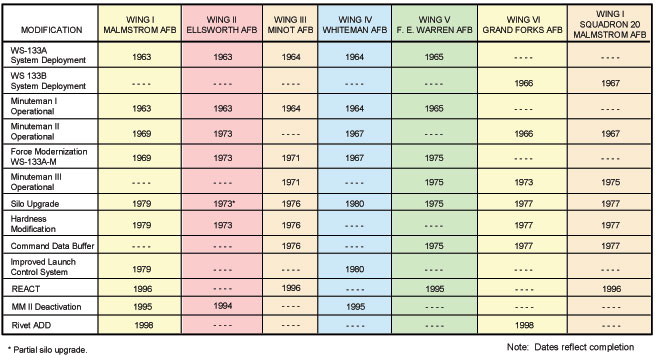Minuteman System Upgrades
The first generation of Minuteman, the Minuteman I (LGM-30A and B), was a highly reliable, three-stage, solid-propellant missile, capable of withstanding storage in an alert "ready" condition for long periods of time. Minuteman I ground systems were designated WS-133A, and missiles were installed in underground launchers located at unmanned sites. Each missile was capable of being launched, even after being subjected to overpressure from a nuclear blast, with a range of over 5,000 nautical miles and a continuously operating guidance set.
The basic characteristics of the WS-133 weapon system have not changed since Minuteman I missiles were deployed. However, advances in technology and changes in national policy induced improvements in the original design. The 800 Minuteman I missiles which stood guard over 20 years ago were replaced by the more capable Minuteman II (LGM-30F) and later, by the Minuteman III (LGM-30G) missiles, shown below. The ground systems, which house and support the missiles, have also been made more survivable, efficient, and secure over the years. In June 1992, the Air Force began retiring Minuteman II so that the LGM-30G missile was the only version of Minuteman fielded by 1995.
UpgradesBy 1964 major improvements had been made to the original ground system and missile design, and Wing VI was built with these improvements to accommodate the Minuteman II missile. This ground system was designated WS-133B. After Wing VI deployment, the same new ground system was used to add one squadron of Minuteman II missiles to Wing I. This is Squadron 4 of Wing I, but has been referred to as the "Colocated squadron" or "Squadron 20," as it was the 20th Minuteman squadron deployed in the force.
After the WS-133B ground system was built, the WS-133A ground system at Wings I and III through V was modified to incorporate characteristics similar to those of the WS-133B system in order to accommodate either Minuteman II or Minuteman III missiles. This included the installation of the Command Data Buffer (CDB) at all wings except Wing II to provide remote retargeting capability and other upgrades. Also, new requirements were established to increase the system's "nuclear hardness." Nuclear hardness is a term representing how resistant a system is to nuclear effects. Initially, the hardness was upgraded to a limited extent at Wing II. Later, a more extensive hardness upgrade was performed at the remaining wings beginning with Wing V. The changes were implemented as part of the Force Modification and Silo Upgrade Programs. After a WS-133A wing was modified, it was given the new designation WS-133A-M.
The concrete-walled subsurface Launcher Support Building (LSB) at Wings I - V was originally constructed with only a limited degree of nuclear hardness. The Launcher Equipment Building (LEB) at Wing VI and Squadron 20 was encapsulated and buried underground to increase nuclear hardness. Direct attack hardness requirements for both the LSB and LEB were deleted in the 1980s, leaving only electromagnetic pulse (EMP) requirements for these facilities.
Part of the equipment in the LCSB at Wings I and II (the standby electric power and the environmental control for the building and for the LCC capsule) was moved underground at Wings III, IV, and V and was encapsulated at Wing VI and Squadron 20.
An integrated improvement program was started in the early 1970s. This program incorporated the following improvements: EMP hardening, silo upgrade to improve hardness, the Command Data Buffer for remote programming of the guidance system, and dust hardening of the MM III Propulsion System Rocket Engine (PSRE) by installing covers over the attitude control motors.
Other significant milestones in the Minuteman system deployment were the Rivet SAVE program which allowed a one-third reduction in the crew force; the Stage 2 Washout and Stage 3 replacement of aged-out booster motors; the Accuracy, Reliability, and Supportability Improvement Program (ARSIP) for the MM II NS-17 MGS; the partial replacement of LF batteries with high-life lithium storage batteries for extended survivable power; and the Rivet Minuteman Integrated Life Extension (MILE) depot level maintenance program.
By 1987, the Minuteman force configuration stood at 450 Minuteman IIs and 500 Minuteman IIIs after the deployment of 50 Peacekeeper missiles in Minuteman Silos (PIMS) was completed in 1986. The decision to begin retiring the Minuteman II system in 1992 resulted in the deactivation of Wing II based at Ellsworth AFB, Rapid City, SD and Wing IV based at Whiteman AFB, MO. At the same time, 30 Minuteman III missiles were taken from storage and placed in the A-M system in Wing I as part of the Rivet ADD program. This brought the total of Minuteman III missiles deployed to 530, as well as the 50 Peacekeeper missiles deployed in Wing V, by the end of 1995. The Base Realignment and Closure (BRAC) decision in 1995 to close Wing VI at Grand Forks AFB, ND, was accommodated by moving 120 Minuteman III missiles to Wing I, bringing the eventual total MM III missiles deployed to 500 by the end of FY98.

Minuteman Deployment and Modification